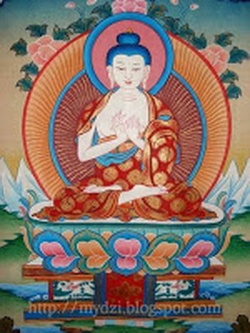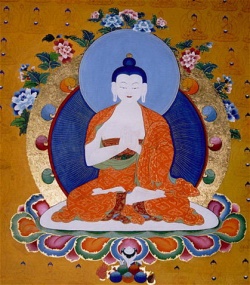Five Dhyani Buddhas: BhadrasBlog
Vairochana - He Who Is Like the Sun
Vairocana Buddha is sometimes called the primordial Buddha or supreme Buddha. He represents the Wisdom of Shunyata, "Emptiness." He is considered a personification of the Dharmakaya -- everything, unmanifested, free of characteristics and distinctions. When the Dhyani Buddhas are pictured together in a Mandala, Vairocana is at the center. Vairocana is white, representing all colors, and his his Symbol is the Dharma Wheel. His hand Mudra represents the turning of the Wheel. He is associated with the first Skandha, Form. Meditation on Vairocana vanquishes Ignorance.
Akshobhya - The Immovable Buddha
Akshobhya was a Monk who vowed never to feel Anger or disgust at another being. He was immovable in keeping this vow, and after long striving he became a Buddha.
Akshobhya is a heavenly Buddha who reigns over the eastern paradise, Abhirati. (Note that the eastern paradise is understood to be a state of Mind, not a physical place.) Those who fulfill Akshobhya's vow are reborn in Abhirati and cannot fall back into lower states of Consciousness.
In Buddhist iconography, Akshobhya usually is blue, sometimes gold. He is most often pictured touching the earth with his right hand. This is the earth-touching Mudra, which is the gesture used by the historical Buddha when he asked the earth to bear witness to his Enlightenment.
In his left hand Akshobhya holds a Vajra, the Symbol of Shunyata -- an absolute reality that is all things and beings, unmanifested. Akshobhya also is associated with the fifth Skandha, Consciousness.
In Buddhist Tantra, evoking Akshobhya in Meditation helps overcome Anger and hatred.
Ratnasambhava - The Jewel-Born One
Ratnasambhava Buddha represents richness. His yellow color symbolizes earth and fertility, and he holds a wish-fulfilling jewel. He reigns in the South and is associated with the second Skandha, sensation. Meditation on Ratnasambhava Buddha vanquishes pride. He holds his hands in the wish-fulfilling Mudra.
Amitabha - Buddha Of Boundless Light
Amitabha Buddha, who is also called Amita or Amida Buddha, probably is the best known of the Dhyani Buddhas. In particular, devotion to Amitabha is at the center of Pure Land Buddhism, one of the largest schools of Mahayana Buddhism in Asia. In long-ago time, Amitabha was a king who renounced his kingdom to become a Monk. Called Dharmakara Bodhisattva, the Monk practiced diligently for five eons and realized Enlightenment and became a Buddha.
Amitabha Buddha reigns over Sukhavati, The Western Paradise, also called the Pure land. Those reborn in the Pure land experience the Joy of hearing Amitabha teach the Dharma until they are ready to enter Nirvana.
Amitabha symbolizes mercy and Wisdom. He is associated with the third Skandha, that of Perception. Tantric Meditation
on Amitabha is an antidote to desire. He is sometimes pictured in between the bodhisattvas Avalokiteshvara and Mahasthamaprapta. In this image, Amitabha's hands are in a Meditation Mudra. His Symbol is the Lotus, representing Gentleness and purity.
Amoghasiddhi - He Whose accomplishment is Not in Vain
In the Bardo Thodol -- the "Tibetan Book of the Dead" -- Amoghasiddhi Buddha appears to represent the accomplishment of all action. He holds a crossed Vajra, also called a double Dorje, representing accomplishment and fulfillment in all directions. He radiates a green Light, which is the Light of accomplishing Wisdom.
Amoghasiddhi Buddha reigns in the north, and he is associated with the fourth Skandha, volition or Mental formations. Meditation on Amoghasiddhi Buddha vanquishes envy and jealousy. In this image his hand gesture is the Mudra of fearlessness.

